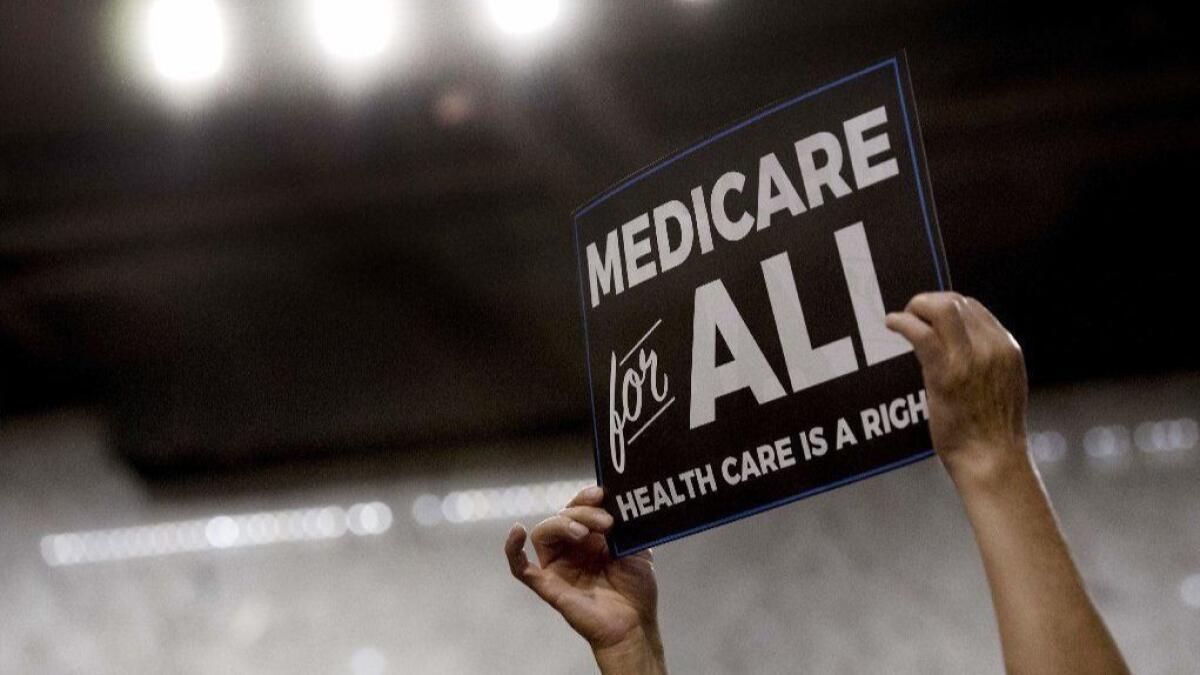Column: $32 trillion for ‘Medicare for all’? It’s a bargain

- Share via
Democrats have done a miserable job selling “Medicare for all” to the American people.
They’re adept at highlighting the myriad problems with our healthcare system — the high costs, the millions uninsured, the financial devastation of getting sick.
But when it comes to solutions, most of the Democratic presidential candidates offer vague policy proposals and sidestep pointed questions about how much healthcare reform would cost.
This is simply foolish. On both counts — policy and price — the Dems have a winning political issue.
They can point to other developed countries in making the case for the economics and effectiveness of public health plans, whether we’re talking Medicare for all or a similar “public option.”
And they can point to current healthcare spending to make a case for why their proposals would cost less than the status quo that conservatives are determined to defend.
Gerald Kominski, a professor of health policy and management at UCLA, tells me the problem with communicating these ideas is that the scope of the problem is so large, and the underlying components so complex, many people can’t get their heads around such difficult policy matters.
“This easily slips into Nerd Land,” he said.
But once you clear away all the policy brush, Kominski observed, there’s a fairly simple message to be conveyed about Medicare for all or any other single-payer system.
“Most families would be better off,” he said.
There it is.
Yes, this is all very complicated. And, yes, there would be nothing easy about transforming the U.S. healthcare system into one more in line with our economic peers.
But let’s emphasize Kominski’s point: Most families would be better off.
That’s the case Democrats should be making, again and again, to the American people.
More than a third of Democratic voters who turned out for New Hampshire’s first-in-the-nation primary this week said healthcare was the most important issue in this presidential election.
Even Republicans say healthcare is one of their most pressing concerns, according to a recent Gallup poll.
Yet critics of Medicare for all say the idea is a non-starter because of its astronomical cost.
They cite a study published last year showing that if Vermont Sen. Bernie Sanders’ proposal for a comprehensive single-payer system were enacted, it would cost about $32 trillion in new federal revenue over 10 years.
Thirty-two trillion! Many Americans couldn’t even tell you how many zeroes are in a number that grotesquely huge.
What Democrats have done a terrible job communicating is that we’re currently spending $3.6 trillion a year on healthcare. That translates to $36 trillion over the next decade.
But the status quo is actually way worse than that.
The federal government estimates that national healthcare spending will total about $48 trillion over the next 10 years as costs keep going up.
By 2027, according to the Centers for Medicare and Medicaid Services, we’ll be spending about $6 trillion annually on healthcare. Total spending over the subsequent 10 years likely will reach a staggering $60 trillion — at least.
That’s the cost of doing nothing. It’s what opponents of healthcare reform are saying is our best option.
And that, of course, is insane.
“We’ve gotten ourselves into a big hole by letting expenditures get out of hand,” said Vivian Ho, a healthcare economist at Rice University. “It’s happening right before our eyes, and we’re not doing anything about it.”
The American people already spend more for healthcare than citizens of any other developed country. Again, this is a message that Democrats fail to get across.
The average American represents more than $10,500 a year in healthcare spending, according to the Organization for Economic Cooperation and Development. (The U.S. government has an even higher figure: $11,172 per person.)
That compares with less than $6,000 per person in Germany, less than $5,000 in France and Canada, and about $4,000 in Britain, according to OECD statistics.
Are we at least getting a proportionally bigger bang for our healthcare buck? Apparently not.
Americans have shorter average lifespans and a higher infant-mortality rate than people in these other countries — two key metrics of healthcare efficacy.
How do other nations do it? Simple. Each of these countries has a variation of single-payer insurance systems that use economies of scale to make healthcare more accessible and affordable.
That’s the entire case for Medicare for all right there: It costs less and works better.
Here’s where opponents of healthcare reform raise their hands and say, “But higher taxes!”
And again, Democrats have failed spectacularly in explaining how these higher taxes would be offset by reductions in insurance premiums, copays and deductibles.
Yes, taxes would rise under a Medicare-for-all system. The system would be funded almost entirely by tax dollars, as is the case in other developed countries.
But when you take most insurance premiums, copays and deductibles out of the equation, guess what happens. Total out-of-pocket costs for most people go down.
Rand Corp. analysts studied a single-payer proposal for the state of New York. They found that “the majority of New Yorkers would pay less” under such a system, “while the highest-income residents would pay more.”
Researchers at the University of Massachusetts Amherst concluded that a nationwide Medicare-for-all system would result in about $5 trillion in savings over 10 years.
“There would also be broader macroeconomic benefits through operating the U.S. healthcare system under Medicare for all,” they noted.
“Among these are that improved health outcomes will raise productivity; Medicare for all will support greater income equality; and that Medicare for all should support net job creation, especially through lowering operating costs for small- and medium-sized businesses.”
This is the message single-payer advocates need to be conveying: Solutions are available, and they’ve already been battle tested in other countries.
Personally, I disagree with Sanders’ plan, which would eliminate private health insurers and place responsibility for coverage solely on the government.
A more practical (and politically feasible) approach would be to emulate the healthcare systems of Germany, France and Japan, which rely on payroll deductions to fund nonprofit private insurers.
Under such systems — known in healthcare circles as the Bismarck model — the government plays an active role in determining what must be covered and how much can be charged for treatment. No one is excluded, regardless of preexisting conditions.
Yet the market still benefits from having private insurers compete for business, which leaves room for more comprehensive coverage for anyone willing to pay more, as well as cheaper plans for younger people who may want to pay less.
Problems abound, of course. How much should doctors and hospitals be reimbursed for treatment? Who determines fair prices for prescription drugs?
Moreover, would having more people insured drive up doctor visits, placing an even greater strain on healthcare resources? These questions need to be answered and addressed.
Some experts say the cost-savings argument isn’t the pitch Medicare-for-all proponents should be making.
“What single-payer advocates should do, in my own opinion, is not make an argument about lowering costs or make an argument that this will not be an expensive endeavor,” said Anupam B. Jena, an associate professor of healthcare policy and management at Harvard University.
“The argument must be made on humanitarian grounds,” such as expanded coverage and accessible treatment, he said.
At least we wouldn’t be starting from scratch. We’d have the luxury of picking and choosing what works best from other countries’ decades of experience.
And if we do things right, Americans would enjoy the same savings as our counterparts abroad and, with hope, the same improvements in health outcomes.
That’s the story Democrats need to be telling.
And when opponents of reform put up a fight, the reply is, “So you like paying more for worse results?”
That’s a hard position to defend.
More to Read
Inside the business of entertainment
The Wide Shot brings you news, analysis and insights on everything from streaming wars to production — and what it all means for the future.
You may occasionally receive promotional content from the Los Angeles Times.











